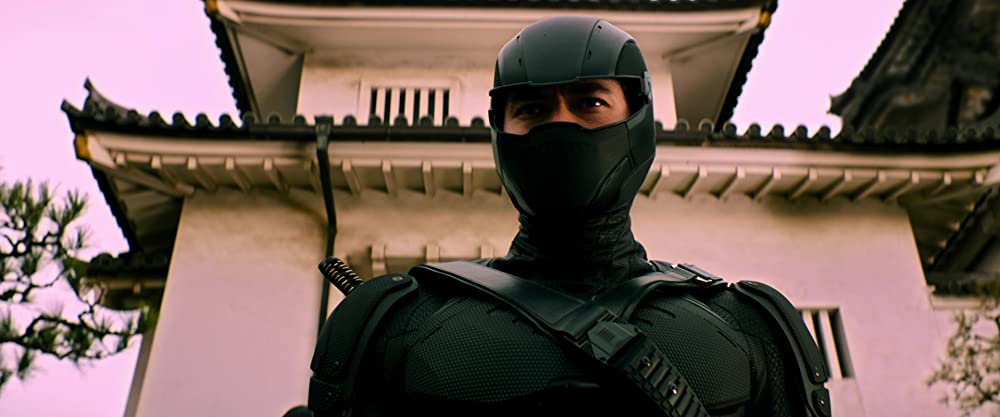Per Matt
If the only things you know about G.I. Joe come from the mediocre big-screen releases of the past 13 years, then you don’t really know Joe. With each outing, MGM and Di Bonaventura Pictures have teamed up to drag the Real American Hero kicking and screaming into the 21st century. It’s just too bad that Snake Eyes is the third big-screen strike, which has failed to grow the franchise despite plenty of opportunities.
Does the Hasbro property deserve yet another opportunity to sell more toys, comics, Blu-rays and ancillary merchandise, in hopes of interesting nostalgic kids of all ages? And will the G.I. Joe film franchise survive the Snake Eyes flop?
Being completely transparent, I’m a lifelong fanboy of the franchise. As a Child of the ’80s, I consumed everything Joe I could get my hands on. When I grew up, I continued to look back fondly on it all, although each attempt to bring something new to the familiar characters always fell flat, paling in comparison to the original.
In 2009, The Rise of Cobra premiered almost 30 years after Hasbro initially brought the action figures to life. Even though it was directed by Stephen Sommers, it was instantly forgettable. Focused on emerging technology and goofy humor, its story elements strayed far from the original source material.
Four years later, Jon M. Chu’s Retaliation was closer to A Real American Hero, although there was too much nanotechnology for my tastes (and Duke’s hair is supposed to be blond, dammit!). Pairing Dwayne Johnson with Bruce Willis within this universe was a plus.
Shockingly enough, there haven’t been many video games based on the franchise. Operation Blackout, released not too long ago by IguanaBee and Fair Play Labs, was a decent opportunity to grow an audience, this time with gamers. The Toys That Built America highlighted the battle for the consumer’s all-mighty money, as Joe fought Barbie for marketplace supremacy. And less than seven months ago, Paramount Pictures released the third blockbuster movie based on the franchise, but you probably didn’t even notice it.
Snake Eyes: G.I. Joe Origins is no franchise spinoff. It is no world builder. This is the byproduct of so-called filmmakers thinking they knew how to adapt a popular ’80s line of comics, toys and cartoons, but the truth is, they really didn’t. Released during the global pandemic with a title that was changed didn’t help matters much.
On the run from the Yakuza, the unnamed main character is drawn into the Arashikage clan via his friend, Tommy. So, a sarcastic Snake Eyes — sans mask — is both a hero and a villain, working for and against his buddy in a film that’s mostly based in Japan, but primarily spoken in English (naturally) and released as a movie theater exclusive amid growing fears of Omicron. To say that this movie didn’t quite connect with its intended audience is an understatement. What was the disconnect?
The actors were replaceable in previous films, never truly embodying the individual personalities of the characters they portrayed. Whether they were killed off or recast in this origin story, it was almost as if Lorenzo di Bonaventura and his fellow filmmakers were taking a cue from Michael Bay’s Transformers (another misaligned big-screen Hasbro property). There was really no sense of continuity, whatsoever, with the exception of an impending “ruthless terrorist organization determined to rule the world…”
Martial artist Ray Park, who previously appeared onscreen as the character, wasn’t retained for this one, replaced by Henry Golding. That, in itself, was a big question among fans. Ever since Hasbro introduced the character, Snake Eyes was silent, masked warrior. This one doesn’t don a mask until the final battle, but he speaks throughout the overlong story. That might feel groundbreaking, but more of the uproar came from fanboys upset at Golding’s British and Malaysian background.
If that wasn’t a kick in the teeth for fans, this story feels dumbed down for a franchise’s most popular character. When the overall theme is revealed to be a revenge fantasy to right a past wrong that manufactures a girl-powered finale, all I could wonder is, “Why?”
Strategic backstory elements are used, while others are totally ignored, making this Snake Eyes in name only. What’s the reason to release this film if you aren’t going to address the white elephant in the room?
“We all make mistakes. It’s what we do next that really matters…”
Character creator Larry Hama previously spoke up about telling new stories for well-known characters, “You have to understand that almost all of G.I. Joe has always been retconned.”
That doesn’t excuse this Paramount Pictures release from disrespecting the original source material, but since Hama did such a great job imparting depth and personalities to so many pieces of plastic, he gets a partial pass. “Silent Interlude” was groundbreaking for Marvel Comics, where he was a writer (and sometimes artist), yet here, the character is more unlikable than any situation ever presented within the printed medium. That’s not a good thing.
This film felt more like an origin story for Storm Shadow, who’s more sympathetic in comparison, but even his story is slightly askew. Originally, the only reason this character joined COBRA was to find the killer of the Hard Master. So, he isn’t brainwashed… yet. But that never really happened?
Director Robert Schwentke (of R.I.P.D. and the Divergent franchise fame) did what he could, but it really wasn’t enough (Can we stop with the shaky cameras already?). Much like Solo, this prequel felt misguided, to say the least.
The franchise deserves better stories, so it’s time to bring in some new blood as storytellers and producers. When will Hasbro realize these feature films should actually make money hand over fist, instead of writing off hundreds of millions of dollars? I will continue waiting for the first good G.I. Joe film that remains somewhat faithful to its origins, but Snake Eyes is definitely not that.

